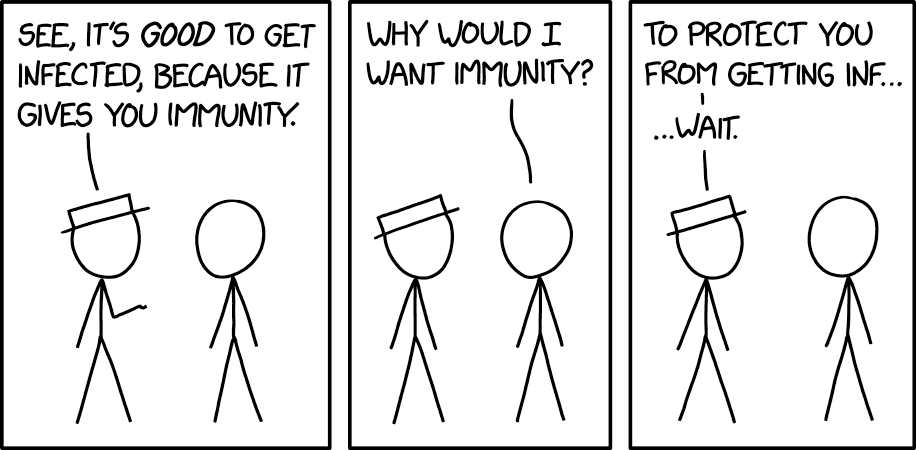
Oh, we understand the claims of "immunity debt" (est. 2021) just fine. 🧵
There's the trivially true population version of "immunity debt" in which lack of infections means an immunologically naïve population. Terrible name for this obvious phenomenon.
1/
There's the trivially true population version of "immunity debt" in which lack of infections means an immunologically naïve population. Terrible name for this obvious phenomenon.
1/
A corollary of the population version is that mitigation works very well, so it makes sense to mitigate when there's way too many infections at once.
/2
/2
Then there's the absurdly silly individual version where the immune system needs to be worked out like a muscle and the way to avoid being infected with pathogens is to be infected with pathogens.
3/
3/

The individual level version is a twisted take on the hygiene hypothesis (you know, let kids play in the dirt -- it does not say let them play in a biohazard lab).
4/
4/
Here's the thing. It is not obvious from the population version why you'd see hospitalizations going up while infection rates are not higher than last year. This suggests that infections are *more severe* on average, but not necessarily more common.
5/
5/
The individual version would be consistent with this, but it's a nonsense explanation.
Obviously, immune damage from COVID infection could also account for increased severity. If kids are at greater risk due to immune damage, mitigating infection would be very prudent.
6/
Obviously, immune damage from COVID infection could also account for increased severity. If kids are at greater risk due to immune damage, mitigating infection would be very prudent.
6/
Whichever it is (naïve population and/or immune damage -- but not the silly individual immune muscle version), mitigation during the current crisis makes sense.
Unfortunately, many of the people pushing the "immunity debt" interpretation argue *against* those measures.
7/
Unfortunately, many of the people pushing the "immunity debt" interpretation argue *against* those measures.
7/
It also bears nothing that:
* Early childhood infection with RSV can make later infections *worse*.
* Rates of RSV were high *last year* in many places. So why is there still immunity debt this year?
* Early childhood infection with RSV can make later infections *worse*.
* Rates of RSV were high *last year* in many places. So why is there still immunity debt this year?
* Immunity to RSV doesn't last very long anyway, even if people had gotten infected two years earlier.
* There isn't an obvious pattern of more flu and RSV in places where there were more stringent mitigation measures.
* There isn't an obvious pattern of more flu and RSV in places where there were more stringent mitigation measures.
I'm sure the minimizers who argued against mitigating COVID in kids and are now blaming lockdowns, masks, and remote schooling for severe RSV and flu are framing criticism as ideological ("everything is COVID to them") or a misinterpretation ("we just mean the population thing").
Inventing a term ripe for confusion doesn't help anything, and dismissing a possibly very serious risk to children's health is unacceptable. The fact that there is a very clear vested interest in it not being a consequence of letting COVID rip in kids is relevant.
There's also the issue of credibility debt.
https://twitter.com/TRyanGregory/status/1589399809047564289?t=8EWKbM83qfFWvsB4Qouc5Q&s=19
• • •
Missing some Tweet in this thread? You can try to
force a refresh






